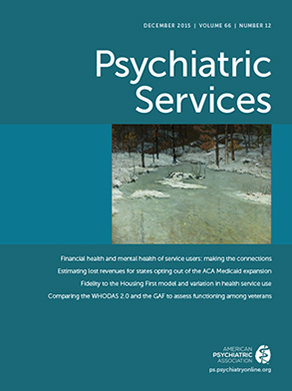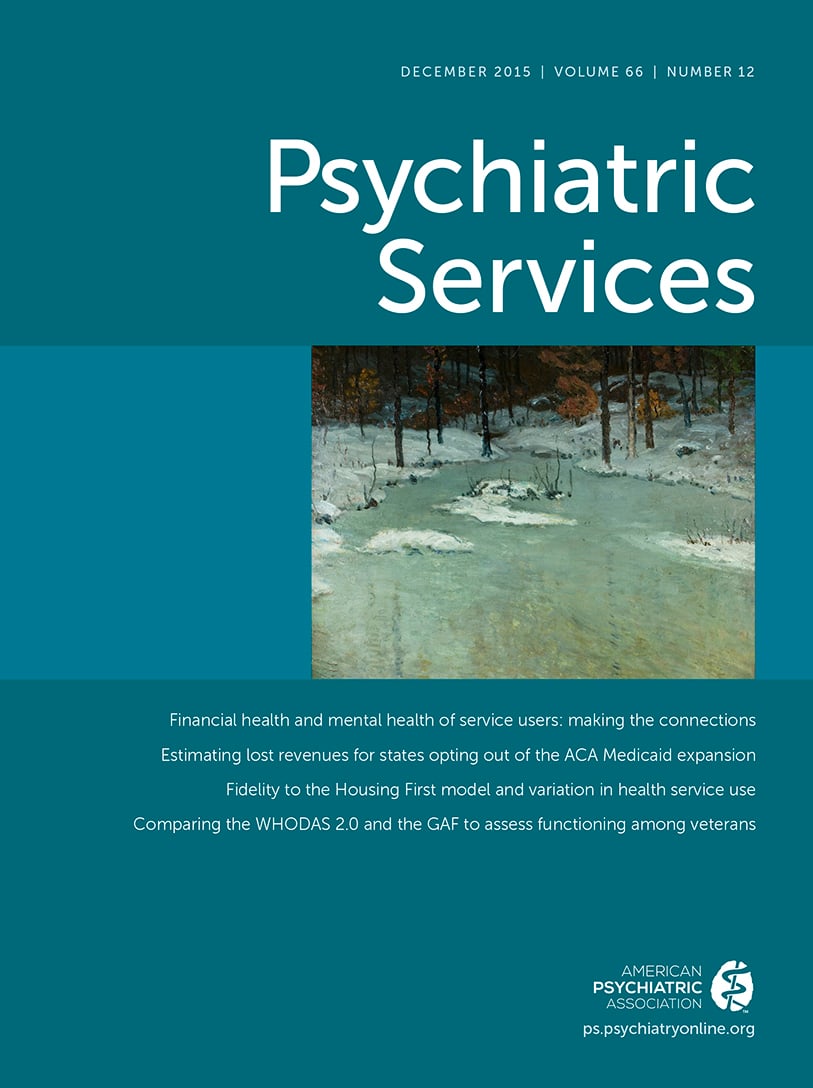The age-adjusted risk of mortality for people with serious mental illness is 2 to 2.5 times greater than for the general population, primarily due to chronic general medical conditions (
1–
3). Because people with serious mental illness are most likely to access health care in community mental health (CMH) settings, CMH settings are an ideal venue to target general medical interventions to address this excess mortality. However, surveys of CMH providers and organizations have demonstrated multiple barriers to implementing general medical interventions, including insufficient training, workforce and reimbursement limitations, uncertainty about roles, and patient factors (
4–
7). The evaluation of the Substance Abuse and Mental Health Services Administration’s Primary Behavioral Health Care Initiative to implement general medical services in CMH settings demonstrated that among the most concerning barriers to implementation were consumer engagement and financial sustainability (
8). Stakeholder involvement, especially consumer involvement, may be a means to address these barriers to successfully implement sustainable general medical interventions in CMH settings.
Community-Partnered Participatory Research and Engagement of a CMH Organization
Community-partnered participatory research (CPPR) can address identified barriers to successful CMH general medical interventions, such as consumer engagement, sustainability, and role definition, and can provide a mechanism to establish an evidence base around successful and sustainable general medical interventions. In the CPPR framework, community partners and researchers collaborate as equals to develop a common “vision” or framework for partnership, to traverse the “valley” of designing and implementing the research plan, and to celebrate “victory” of the evaluation and achievement of shared goals (
9). CPPR differs from traditional community-based participatory research in its manualized emphasis on equal partnership between researchers and the community. This partnership includes coleadership, equal coordination in framing and conducting research, shared responsibility for resources, and equal respect for the knowledge and experience of both the research and community partners. This framework has been successfully used to improve depression screening and services in underresourced communities (
10).
The project described here was a partnership between the Robert Wood Johnson Foundation Clinical Scholars program at the University of California, Los Angeles, and Pacific Clinics, a large CMH organization in the greater Los Angeles area spanning five counties with more than 1,200 employees. The formation of the partnership began with the researcher (SPI) identifying a key representative within Pacific Clinics (LSP) familiar with public-academic partnerships. They collaboratively identified a core need in Pacific Clinics for standardized and sustainable general medical screening across the organization. The partnership then expanded by branching outward within the organization to identify representatives from other critical stakeholder groups, including nursing, medical staff, quality assurance, and consumers. Consumer representatives were specifically sought out. Members of the created stakeholder committee, which was cochaired by a consumer, had intentional overrepresentation of consumers.
From January 2013 to June 2014, 19 stakeholder committee meetings were held every three to four weeks, though this committee has continued to meet regularly after the end of the formal CPPR process. Initial engagement began with community-building narratives about general medical health and wellness, including personal experiences and experiences working with consumers at Pacific Clinics, particularly an active consumer in the organization who died due to an undetected general medical condition. These narratives and an informal survey of providers and managers across the organization led to the collaborative development of a three-step framework for addressing the general medical health and wellness of both consumers and staff. The first step in this process is engagement of both staff and consumers together in programs such as whole health and wellness activities (for example, nutrition and shopping classes) or motivational interviewing training for both providers and consumers. Successful engagement subsequently leads to an interdisciplinary general medical health and wellness assessment of consumers, including factors beyond biological measurements, such as lifestyle, habits, diet, and access to medical services. The third step is to provide targeted interventions to consumers with identified needs, including evidence-based tools, group-based interventions, brief counseling, and/or facilitated referral to external services. [The full three-step framework is provided in a table in an online supplement to this column.] This framework was then used to design a sustainable intervention aimed at both consumers and staff general medical health and wellness, with pilot testing at two sites in the organization.
Benefits and Challenges of CPPR in a Large CMH Organization
To evaluate the use of a CPPR framework, reflection sheets were collected from committee representatives at each meeting. Audio recordings and process notes from each meeting were generated, and independent semistructured qualitative interviews were conducted with each committee member. These data were analyzed using a content analysis framework, with identified key themes and inferences verified by the committee as part of its working meetings. Committee members felt enhanced in their understanding of general medical issues faced by consumers and even their own health and wellness. All committee members reported both in real time and in retrospect that their representative group’s voice was heard and incorporated in decision making and that the committee was effective in accomplishing its goals. Although several expressed concern about insufficient representation of line staff, committee members felt the intervention ensured clarity of staff members’ roles in addressing general medical health and wellness while ensuring productivity and reimbursement. However, many committee members expressed frustration with the pace of work under the CPPR framework, especially compared with standard decision making in the organization and the challenge of balancing individual representatives’ concerns in finding common ground. On subsequent reflection, the researchers and community partners felt that part of this frustration may stem from CPPR principles not being oriented to the environment of a CMH organization primarily incentivized by reimbursable services and productivity and where new programs and services are generally implemented in a top-down fashion. Ultimately, all committee members expressed pride in and support of the products created, and all representatives expressed confidence in the sustainability of both the committee and the implementation.
Consumer Involvement in Partnered Research
Consumers on the committee expressed a strong satisfaction with participation, both in terms of improvement of their own self-efficacy, knowledge base, and empowerment, and their feeling of being able to support fellow consumers through their work. As noted by both the consumer and nonconsumer representatives in interviews, consumer participants were more oriented toward wellness activities (especially nutrition education) and chronic disease management than toward general medical screening. This focus derived from their own lived experience with chronic general medical conditions, and it broadened the perspective of the committee to include these elements as part of the intervention as a means to improve consumer engagement. Consumers also expressed frustration at the inability to implement more general medical and wellness services and requirements quickly and at limitations inherent to the capacities and licensing of CMH organizations, especially with regard to chronic disease management. Consumers also faced numerous barriers to being incorporated as decision makers within the organization. Despite Pacific Clinics being a progressive recovery-oriented CMH with active consumer input and representation, consumer committee members faced functional challenges of finding reliable transportation, office space, and access to Internet service, often limiting consumers’ abilities to fully engage in committee activities and communication.
Nonconsumer committee representatives also were asked about their experience working with consumers in organizational decision making, all of whom reflected that this experience was unique. Some of them expressed a level of frustration that the pace was sometimes slowed by consumers, in part due to perceived differences in knowledge level but also due to their perception that consumers occasionally prioritized their own individual experiences rather than task accomplishment and organizational needs. However, nonconsumer committee members almost universally expressed support of involvement of consumers, stating that strong consumer representation and their stories helped recognize the importance of the connection between physical and mental health, including how to use this connection to support reimbursement of general medical and wellness services in CMH. The effectiveness of consumer narratives in the committee’s work led to the incorporation of personal stories and lived experiences with general medical conditions into the designed intervention.
Conclusions
CPPR offers a framework for researchers seeking to study and implement sustainable general medical and wellness interventions in CMH settings. This framework helps to address identified barriers of role confusion, consumer engagement, sustainability, and reimbursement. The involvement of consumers offers perspectives that might otherwise not be incorporated into research or quality improvement interventions, particularly with establishing priorities most relevant to the end users of the intervention, and helps ensure that the process and outcomes are recovery oriented. Broad stakeholder representation, especially inclusion of quality assurance or other staff responsible for monitoring reimbursement and compliance, can help align organizational requirements with research so as to ensure sustainability. In this study, stakeholder and especially consumer involvement led to the creation of a novel three-step framework using whole health and wellness activities for both consumers and staff as a means toward engagement for general medical screening. While prior work on general medical health in CMH settings has focused on these elements separately, the input of stakeholders, particularly consumers, led to the design of a unique intervention bringing these two elements together and thus addressing identified barriers to screening. The partnership between consumers and staff on the committee similarly led to a unique facet of the intervention where staff and consumers “partner” in engagement through health and wellness activities, benefiting both. The inclusion of personal narratives to improve engagement around health assessment also was a direct result of the CPPR process. The effect of these novel elements on sustainability of the designed intervention is being evaluated currently.
However, participatory inclusion of stakeholders and consumers poses challenges to performing traditional effectiveness and implementation research. This is particularly true in CMH settings where financial and productivity goals may not easily fit within the CPPR process and where consumers may not be included in the organization’s decision-making structure or day-to-day operations. However, the CPPR framework provides an outlet for conflict to arise and be worked through to provide transformative change. These principles may represent a major cultural shift for more corporate organizations, such as the incorporation of consumer narratives in decision making and quality improvement interventions seen here. Nevertheless, a baseline assessment of stakeholders’ knowledge and readiness for research within a CPPR framework can help ensure success. Furthermore, ensuring organizational readiness for consumer involvement in decision making at the outset, both in terms of educating nonconsumers and addressing functional barriers, can help improve integration of consumers in the CPPR process in CMH settings.
Acknowledgments
The authors thank the members of the Pacific Clinics Physical Health Stakeholder Committee for their efforts in this work: Erika Aguirre-Miyamoto, Angela Crenshaw, Dolly Ehlen, Sandra Escobar, Viola Gaffaney, Joana Garcia, Rosa Hernandez, Samantha James-Perez, Lisa Lansing, Lou Mallory, David Martel, Lana Martin, Yolanda Mendez, Nina Paddock, Irene Pines, Elizabeth Torres, and Wendy Wang.

